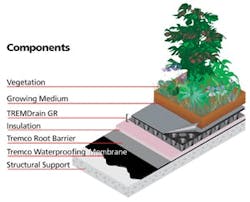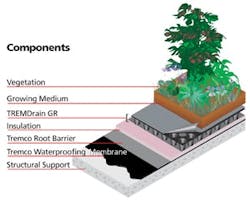Green Roofs
Urban sprawl has turned open land into concrete and asphalt. Greenhouse gas emissions and other pollutants are affecting our air quality. With diminishing open ground available to absorb stormwater, runoff is being carried into combined sewers that carry sanitary sewage and runoff from streets, parking lots, and rooftops.
Green roofs can help building owners and urban areas respond to these problems. They can significantly reduce stormwater runoff, filter particulates out of the rainwater, and break down other pollutants. They can reduce a building's cooling costs by 20 to 30 percent for a single-story building - and reduce sound transmission. They can reduce the urban heat island effect, resulting in lower cooling loads for all buildings and a reduction in the creation of harmful VOCs (smog). It is also estimated that a green roof will double or even triple the life of a roof membrane.
Recognizing the benefits of green roofs, many incentives currently exist for building owners adopting this technology. The U.S. Green Building Council's Leadership in Energy & Environmental Design (LEED) Green Building Rating System™ offers one point if 50 percent or more of a commercial building's roof area is a green roof. In other cases, there are policies that require the implementation of stormwater pollution reduction and flow control measures. Some states and utilities are offering credits and rebates. There is also the potential to reduce the size of HVAC equipment on new or retrofitted buildings and reduce the amount of standard insulation used. In urban areas and areas of concentrated development, even the limited number of buildings with green roofs are having an immediate impact on quality of life.In Germany, green roofs typically come with warranties of up to 30 years due to their durability and the reduction in capital costs associated with roof repair. Today's green roof systems incorporate components that must be installed in layers on a roof surface. Some include 11 layers, starting with a primer and a hot-applied, two-lift system to ensure adequate protection from water penetration. Other systems include only five layers due to the inclusion of a prefabricated drainage mat, which combines the drainage function with water storage and aeration as well as protection for the roofing membrane from roots and other damaging materials. A newly introduced cold-applied waterproofing membrane may be applied in the place of the hot-applied system, eliminating the need for special equipment as well as priming and reinforcement in most cases. Since it may be applied on damp, or "green" concrete, production schedules may be reduced by up to 2 weeks.
Green roofs can help building owners and urban areas respond to these problems. They can significantly reduce stormwater runoff, filter particulates out of the rainwater, and break down other pollutants. They can reduce a building's cooling costs by 20 to 30 percent for a single-story building - and reduce sound transmission. They can reduce the urban heat island effect, resulting in lower cooling loads for all buildings and a reduction in the creation of harmful VOCs (smog). It is also estimated that a green roof will double or even triple the life of a roof membrane.
Recognizing the benefits of green roofs, many incentives currently exist for building owners adopting this technology. The U.S. Green Building Council's Leadership in Energy & Environmental Design (LEED) Green Building Rating System™ offers one point if 50 percent or more of a commercial building's roof area is a green roof. In other cases, there are policies that require the implementation of stormwater pollution reduction and flow control measures. Some states and utilities are offering credits and rebates. There is also the potential to reduce the size of HVAC equipment on new or retrofitted buildings and reduce the amount of standard insulation used. In urban areas and areas of concentrated development, even the limited number of buildings with green roofs are having an immediate impact on quality of life.In Germany, green roofs typically come with warranties of up to 30 years due to their durability and the reduction in capital costs associated with roof repair. Today's green roof systems incorporate components that must be installed in layers on a roof surface. Some include 11 layers, starting with a primer and a hot-applied, two-lift system to ensure adequate protection from water penetration. Other systems include only five layers due to the inclusion of a prefabricated drainage mat, which combines the drainage function with water storage and aeration as well as protection for the roofing membrane from roots and other damaging materials. A newly introduced cold-applied waterproofing membrane may be applied in the place of the hot-applied system, eliminating the need for special equipment as well as priming and reinforcement in most cases. Since it may be applied on damp, or "green" concrete, production schedules may be reduced by up to 2 weeks.
The decision to incorporate a green roof need not be hindered by concerns about cost, weight, durability, and maintenance. Today, there are systems engineered to be effective, simple to install, and light in weight. Between economic benefits, financial incentives, and more cost-effective systems, return on investment may simply be a matter of careful planning.
Eric Horstman is the marketing manager responsible for green roofing systems at Tremco Commercial Sealants & Waterproofing, based in Cleveland.
Eric Horstman is the marketing manager responsible for green roofing systems at Tremco Commercial Sealants & Waterproofing, based in Cleveland.

